|
Report
from
Europe
Mixed signals for tropical hardwood
Overall 2010 was a slightly better year for the European
trade in tropical hardwood than 2009, although purchasing
remained at levels well below those before the recession
and there were unsettling signs of declining market share
in some sectors.
The latest EU-wide trade data indicates that imports of
tropical hardwood logs into the region reached 354,000
cu.m (down 18% on 2009) valued at €133 million (down
7%). The big decline in imports from Gabon following
that country¡¯s log export ban imposed from May 2010
onwards was only partially offset by rising imports from
other countries in the Congo basin.
Nevertheless, quarterly data indicates that after reaching
an all time low in the third quarter of 2010, the pace of
imports of tropical hardwood logs picked up significantly
in the closing months of the year. EU-25 imports of
tropical hardwood logs during the October to December
period reached 108,000 cu.m, up from only 78,000 cu.m in
the previous quarter.
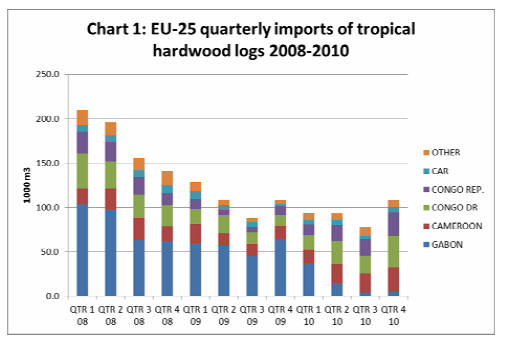
Interestingly, EU imports of tropical logs in the last
quarter of 2010 were almost exactly the same volume as
the same period in 2009, before introduction of Gabon¡¯s
log export ban. Three countries are now filling the void
created by Gabon¡¯s withdrawal as a supplier - Congo
Democratic Republic, Cameroon and the Congo Republic
- each now contributing between 25% and 30% of total
EU imports.
EU hardwood imports up 7percent
EU imports of hardwood lumber (tropical and temperate)
reached 2.69 million cu.m valued at €1435 million, up 7%
and 12.4% respectively. Despite the gains, imports were
still down 42% on levels prevailing before the recession.
This is due both to lower consumption and much reduced
supply as harvesting levels fell dramatically and large
swathes of the hardwood industry were effectively forced
to close during 2008 and 2009.
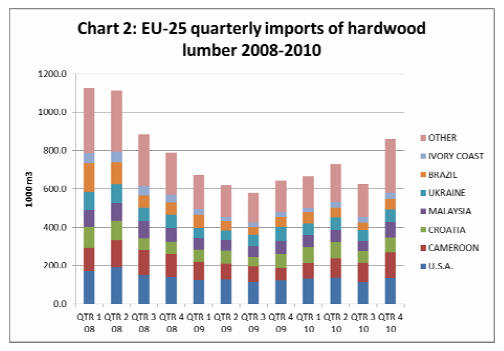
Lack of credit coupled with a desire to keep lower
inventories during times of uncertainty has also fed a
strong trend towards just-in-time ordering which has
tended to favour more readily available hardwoods.
Temperate hardwood lumber producers have benefited
most from this trend, and last year there was significant
growth in EU imports from several Eastern European
supply countries, notably Croatia, Bosnia, Serbia and
Romania.
Of leading tropical hardwood lumber suppliers to the EU,
imports from Malaysia and Brazil fell last year. In
contrast, there was a reasonable recovery in the level of
EU imports from Cameroon. Lumber exports from Gabon
also rose significantly last year, one effect of the log
export ban.
Signs of sustained market improvement in the last
quarter of 2010
The quarterly hardwood lumber import data provides
some cause for optimism that the recovery in Europe¡¯s
sawn hardwood markets will be maintained. There was a
robust rebound in the level of EU hardwood lumber
imports in the last quarter of 2010. During that period, EU
hardwood lumber imports reached 861,000 cu.m, the
highest quarterly figure for over two years. This suggests
that the big decline in imports during the third quarter of
2010 was seasonal and due to short-term stocking issues
rather than a long-term reversal in underlying consumption
trends.
EU imports of hardwood veneer have followed a similar
pattern. Overall EU hardwood veneer imports reached
514,000 cu.m in 2010 valued at €455 million, up 14% and
13% respectively. This is partly the result of a switch to
hardwood rotary veneer imports by European plywood
manufacturers in place of logs from Gabon following the
log export ban in May. In addition to Gabonese exporters,
those in various other African countries are benefiting
from this trend including Cameroon, Ghana and Equatorial
Guinea. Rising levels of veneer imports from countries
better known for supply of sliced veneer ¨C such as Ivory
Coast, USA, and Romania - suggests this component of
the veneer market has also seen some recovery this year.
Strong recovery in veneer imports in October to
December period
As in the hardwood lumber trade, the quarterly data
indicates strong recovery in EU imports of hardwood
veneer in the last quarter of 2010 after a disappointing
performance in the June-September period. The sharp
downturn in EU veneer imports during the third quarter of
2010 seems to have been due to short term over-stocking
of okoume rotary veneer destined for the European
okoume plywood trade, a sector which in recent times has
been struggling to compete with cheap Chinese
substitutes.
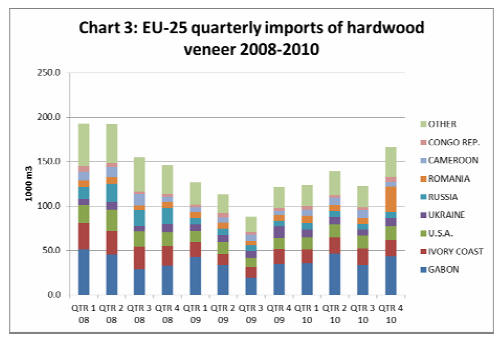
Imports of hardwood plywood into the EU-25 group of
countries during 2010 reached 2.21 million cu.m valued at
€798 million, up 28% and 40% respectively on the
previous year. The particularly sharp rise in the unit value
of imports must be welcome news for a sector that has had
to deal with narrow and ever declining margins over recent
years.
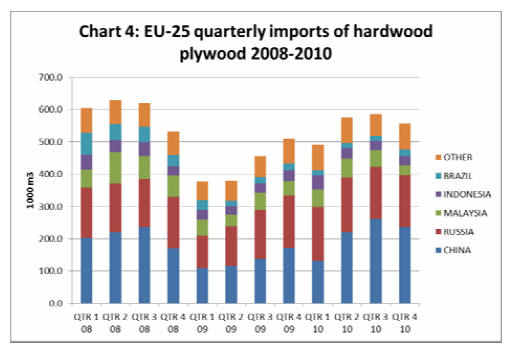
However the data doesn¡¯t bode well for all hardwood
plywood producers. A notable trend in the EU market
during 2010 was growth in the share of China, Russia,
Ukraine, and Uruguay, largely at the expense of Malaysia,
Brazil and Gabon. Tropical hardwood plywood grades
continue to be substituted by cheaper more readily
available combi-products, plantation-grown eucalypt
products, and birch plywood.
The quarterly data is also disappointing, revealing a
significant downturn in EU hardwood plywood imports
during the October to December period last year. This is in
line with market reports indicating a downturn in
European demand for raw grades of tropical and Chinese
hardwood plywood at the end of last year. Following
significant imports of plywood in the second and third
quarters of 2010, many importers were carrying excess
stocks into 2011 relative to limited demand. Demand for
more specialist film-faced products was performing rather
better, continuing to benefit from higher prices and low
availability of birch plywood due to the forest fires in
Russia during 2010 and the Russian export tax on birch
logs.
Certification central to marketing tropical hardwood in Europe
The role of independent certification as an increasingly
essential requirement for marketing of tropical hardwood
in the European market was a central theme of
commentary in the annual Tropical Timber Supplement
published by the Timber Trades Journal (TTJ).
Requirements for certification in the tropical hardwood
sector are currently being driven by Corporate Social
Responsibility policies of larger retailers and
manufacturers and are expected to receive a major boost
with introduction of the ITL. Large housebuilders, retail,
public sector, and merchant customers all demand chain of
custody certification for most products, regardless of
whether they¡¯re tropical or temperate forest-sourced.
Several commentators quoted in the TTJ emphasised the
power of forest certification to overcome existing
prejudices against tropical hardwood in the European
market. Representatives of several large and high profile
wood consuming companies all made the case for
continued use of certified tropical hardwoods as a way of
adding value to sustainably managed tropical forests,
providing incentives for good practice and reducing
pressure to convert forests.
Certification not an easy option
While it is increasingly obvious that certification is a large
part of the answer to tropical wood¡¯s image problem in the
European market, the TTJ supplement also highlights that
this is not an easy option. While an investment in
certification may run into millions of dollars, many
commentators note the continuing lack of willingness to
pay on the part of final consumers. Certification is
required simply to protect existing market share for
tropical hardwood and can¡¯t be expected, in isolation, to
generate a big increase in market demand. In these
circumstances, it seems likely that the largest operators in
the tropical timber sector will be the major beneficiaries
from the shift to certification.
Nevertheless, while there a few positive examples of
progress towards certification in the tropics, many
commentators in the TTJ supplement were seriously
concerned that the pace of uptake is likely to fall behind
the level of demand in the future. There is a widespread
expectation in Europe that demand for certified tropical
wood will pick up strongly over the next two years as the
EU moves towards full implementation of the ITL. This is
raising concerns that the ITL may have negative
consequences in a world where the balance of wood
consumption is shifting inexorably away from western to
emerging markets.
Commentators in the TTJ supplement gave some
consideration to measures that might help overcome these
obstacles. Representatives of European manufacturers and
retailers note their continuing willingness to pay premium
prices for certified tropical wood even when their own
customers are unwilling to pay extra. Others note the
importance of leaving the door open to a range of
certification systems, not just demanding FSC as a default
position, to help keep options open and costs down.
Need to increase EU demand for lesse rused species
The TTJ supplement highlights that there is also a
continuing concern in some quarters to increase the range
of tropical timbers used in the European market so as to
boost availability and the income that may be derived from
certification of tropical forests. The MD of Ecochoice
notes that they recently conducted a study with TRADA
for the UK Environment Agency looking at the
appropriateness of different tropical species for sea
defence works. It¡¯s noted ¡°we had some very positive
findings with angelimvermelho, cupiuba, eveuss, okan and
tali¡the challenge is now fostering demand for these
tested, yet relatively new species. It seems to be all in the
name. Even though we demonstrated that these species do
a great job, customers still want ekki or greenheart. We
need to educate clients to think performance, not species.¡±
Market impact of modified wood products
There were mixed views expressed in the TTJ supplement
on the question of whether ¡°modified¡± softwoods and
temperate hardwoods are having a significant impact on
European markets for tropical timbers. A representative of
UK-based importer UCM suggests the impact is ¡°small¡±
and that it remains unclear how long-lasting it will be. It¡¯s
noted that ¡°tropical timbers are known for durability,
appearance and strength and some modified timbers don¡¯t
replicate all those properties¡±.
In contrast representatives of Lathams and Ecochoiceare
very upbeat about prospects for modified woods,
suggesting that existing technical limitations are being
gradually overcome through further research and testing.
However, in both cases, the suggestion is that modified
wood products are more likely to ¡°supplement¡± than
replace tropical hardwoods.

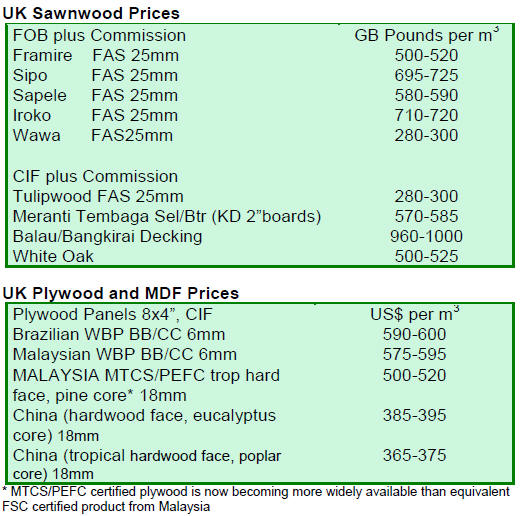 Related News:
¡¡
|